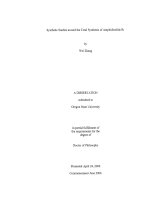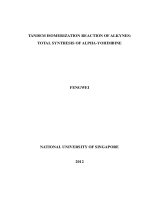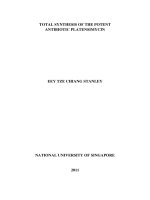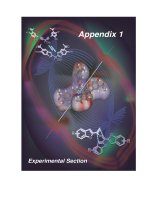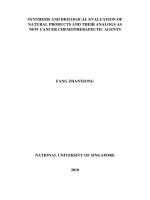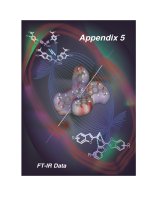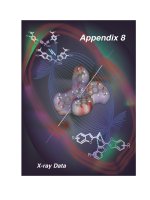Volume 10 the total synthesis of natural products
Bạn đang xem bản rút gọn của tài liệu. Xem và tải ngay bản đầy đủ của tài liệu tại đây (6.63 MB, 186 trang )
THE TOTAL SYNTHESIS
OF NATURAL PRODUCTS
Edited by
David Goldsmith
Department of Chemistry
Emory University
Atlanta, Georgia
..........
...........
THE TOTAL SYNTHESIS
OF NATURAL PRODUCTS
Volume 10
A Sesquidecade of Sesquiterpenes:
Total Synthesis, 1980-1994
Part A: Acyclic and Monocyclic Sesquiterpenes
Michael C. Pirrung and Andrew T. Morehead, Jr.
Department of Chemistry
Duke University
Durham, North Carolina
A Wiley-Interscience Publication
JOHN WILEY & SONS, INC.
NewYork
Chichester
Weinheim
Brisbane
Singapore
Toronto
This text is printed on acid-free paper.
Copyright 0 1997 by John Wiley & Sons, lnc
All rights reserved. Published simultaneously in Canada.
Reproduction or translation of any part of this work beyond
that permitted by Section 107 or 108 of the 1976 United
States Copyright Act without the permission of the copyright
owner is unlawful. Requests for permission or further
information should be addressed to the Permissions Department,
John Wiley & Sons, Inc., 605 Third Avenue, New York, NY
10158-0012.
Library of Congress Cataloging in Publication Data:
CIP data available.
ISBN 0-471-59679-5
CONTENTS
..........................................
Introduction ..............................................
Reagent Glossary ..........................................
I. ACYCLIC SESQUITERPENES ............................
Acknowledgments
A . Farnesene. Farnesol. Terrestrol . . . . . . . . . . . . . . . . . . . . . . . . . . .
B . Nerolidol. 5.8.Dehydro. 4.oxonerolidol . . . . . . . . . . . . . . . . . . . . .
C . Sesquilavandulol . . . . . . . . . . . . . . . . . . . . . . . . . . . . . . . . . . . . . .
D . Solanone . . . . . . . . . . . . . . . . . . . . . . . . . . . . . . . . . . . . . . . . . . . .
E . Sinensals . . . . . . . . . . . . . . . . . . . . . . . . . . . . . . . . . . . . . . . . . . . .
F. Juvenile Hormones . . . . . . . . . . . . . . . . . . . . . . . . . . . . . . . . . . . . .
G. 2.5.9.Trimethyl.2.vinyl.deca.4.8.dienal.
(I9.6.1O.Dimethyl. 9.
methylene-undec-5-en-2-one. . . . . . . . . . . . . . . . . . . . . . . . . . . . .
ix
xi
xv
1
13
H . Dendrolasin, Sesquirosefuran,Freelingnite. Dehydrolasiosperman,
Dehydromyopyrone, (R).Myopyrone. Pleraplysillin.2.
Siphonidictidine . . . . . . . . . . . . . . . . . . . . . . . . . . . . . . . . . . . . . .
I . Ipomeamarone. Davanone. Artemone. Athanasin . . . . . . . . . . . . . .
14
20
References . . . . . . . . . . . . . . . . . . . . . . . . . . . . . . . . . . . . . . . . . . . . . .
25
II. MONOCYCLIC SESQUITERPENES ......................
A . Aromatic Bisabolenes . . . . . . . . . . . . . . . . . . . . . . . . . . . . . . . . . .
1. a.Curcumene, iso.a.Curcumene. ar-Turmerone . . . . . . . . . . . .
2 . Nuciferol, Nuciferal . . . . . . . . . . . . . . . . . . . . . . . . . . . . . . . . .
3. Curcuquinone. Curcuphenols. Curcudiol. Perezones.
Xanthorrhizol . . . . . . . . . . . . . . . . . . . . . . . . . . . . . . . . . . . . . .
4 . ar-Todomatuic Acid. ar.Juvabione. Elvirol. Sydonic Acid . . . . .
5. Hellianuol A. Furoixiolal . . . . . . . . . . . . . . . . . . . . . . . . . . . . .
B . Bisabolenes . . . . . . . . . . . . . . . . . . . . . . . . . . . . . . . . . . . . . . . . . .
1. a.Bisabolene. P.Bisabolene. y-Bisabolenes . . . . . . . . . . . . . . .
29
29
29
36
39
43
44
45
45
V
vi
Contents
2 . Epoxy.a.bisabolene, Bisabol- lO.ene.3.7.oxide. y-Bisabolene8.9.oxide. 4.5.Dihydro.P.curcumen.4. 5.diol . . . . . . . . . . . . . . .
3 . a.Bisabolo1. P.Bisabolo1. a.Atlantone. P-Atlantone . . . . . . . . .
4 . Aminobisabolene. Theonellin Isocyanide.
8-Desoxyisocaespitol . . . . . . . . . . . . . . . . . . . . . . . . . . . . . . . .
5 . Zingiberenol. P.Sesquiphellandrene. Bilobanone.
Bisabolangelone. Lanceol . . . . . . . . . . . . . . . . . . . . . . . . . . . . .
6 . Hernandulcin . . . . . . . . . . . . . . . . . . . . . . . . . . . . . . . . . . . . . .
7 . Juvabiols. Juvabione . . . . . . . . . . . . . . . . . . . . . . . . . . . . . . . . .
8. Paniculides . . . . . . . . . . . . . . . . . . . . . . . . . . . . . . . . . . . . . . . .
9. Phyllanthocin. Phyllanthocindiol. Phyllanthoside . . . . . . . . . . . .
C . Elemanes . . . . . . . . . . . . . . . . . . . . . . . . . . . . . . . . . . . . . . . . . . . .
1. P.Elemene. y.Elemene. a.Elemene. P.Elemo1.
P-Elemenone . . . . . . . . . . . . . . . . . . . . . . . . . . . . . . . . . . . . . .
2 . Shyobunone. Curzurenones . . . . . . . . . . . . . . . . . . . . . . . . . . . .
3 . Melitensin. Deoxymelitensin. Temisin. Saussurea Lactone . . . .
4 . Zempoalins. Callitrin. Igalan. Isogermafurenolide.
Isofuranogermacrene. Hydroxyisogermafurenolide.
Desoxysericealactone. and Unnamed 8. 1ZElemanolides . . . . . .
5 . Vernolepin . . . . . . . . . . . . . . . . . . . . . . . . . . . . . . . . . . . . . . . .
D . Peroxidic Antimalarials . . . . . . . . . . . . . . . . . . . . . . . . . . . . . . . . .
1. Qinghaosu (Artemisinin). Yingzhaosu A. Yingzhaosu C . . . . . .
E . Cyclocitrals . . . . . . . . . . . . . . . . . . . . . . . . . . . . . . . . . . . . . . . . . .
1. Deoxytrisporone. (E).3.Formyl.(2.6.6.trimethyl.2.cyclohexenyl
).
3.pentenal. 4.(2.2.6.trimethyl.6.vinylcyclohexyl).
2.butanone . .
2 . Caparappi Oxide. Dactyloxene-B and .C. Ancistrofuran.
Ricciocarpin . . . . . . . . . . . . . . . . . . . . . . . . . . . . . . . . . . . . . . .
3. Pallescensin 1. Penlanpallescensin . . . . . . . . . . . . . . . . . . . . . .
4 . Snyderols. Aplysistatin. Palisadins . . . . . . . . . . . . . . . . . . . . . .
F. Secoeudesmanes . . . . . . . . . . . . . . . . . . . . . . . . . . . . . . . . . . . . . .
1. Phytuberin . . . . . . . . . . . . . . . . . . . . . . . . . . . . . . . . . . . . . . . .
2. Eriolanin. Eriolangin . . . . . . . . . . . . . . . . . . . . . . . . . . . . . . . . .
3. Tridensone. Umbellifolide . . . . . . . . . . . . . . . . . . . . . . . . . . . . .
G . Germacranes . . . . . . . . . . . . . . . . . . . . . . . . . . . . . . . . . . . . . . . . .
1. Germacrene.D. Bicyclogermacrene. Isobicyclogermacrenal . . .
2 . Hedycaryol. Acoragermacrone. Germacrone . . . . . . . . . . . . . . .
3. Costunolide. Dihydrocostunolide. Haageanolide. Isabelin.
Eucannabinolide. 4.5.cis.3b.Hydroxygermacranolide.
Aristolactone . . . . . . . . . . . . . . . . . . . . . . . . . . . . . . . . . . . . . .
4 . Linderalactone. Neolinderalactone. Sericenine . . . . . . . . . . . . .
5 . Periplanones . . . . . . . . . . . . . . . . . . . . . . . . . . . . . . . . . . . . . . .
H . Miscellaneous Monocarbocyclic Sesquiterpenes . . . . . . . . . . . . . .
1. Humulene. Zerumbone. Bicyclohumulenone . . . . . . . . . . . . . . .
50
53
55
57
60
62
67
71
77
78
84
85
85
88
90
90
97
98
99
103
104
108
108
110
112
114
114
116
118
124
125
129
129
Contents
2.
3.
4.
5.
6.
7.
Furoventalene. Pleraplysillin-1 . . . . . . . . . . . . . . . . . . . . . . . . .
Myodesmone. Myomontanone. Lactaral . . . . . . . . . . . . . . . . . .
Hanegokedial. Heptelidic Acid. Ovalicin . . . . . . . . . . . . . . . . . .
Curcumanolide A. Isocanambrin . . . . . . . . . . . . . . . . . . . . . . . .
Methyl Acorate. Secocrispiolide . . . . . . . . . . . . . . . . . . . . . . . .
Himasecolone. Methyl Nidorellaurinate. Sesquichamaenol.
3-Methyl-5-(2.3.6-trimethylphenyl
)- 1-penten-3-01 . . . . . . . . . . .
8. Karatavic Acid. Cabreuva Oxides. Isohumbertiols. Chokol C . .
References . . . . . . . . . . . . . . . . . . . . . . . . . . . . . . . . . . . . . . . . . . . . . .
............................................
AuthorIndex..............................................
SubjectIndex .............................................
SkeletonIndex
vii
134
138
140
143
145
146
148
150
161
163
166
ACKNOWLEDGMENTS
In any large effort such as this, contributions are made by many beyond those
whose names appear on the masthead. David Goldsmith was an extremely
supportive and insightful editor. Kitty Porter provided great assistance in the
literature search. Financial support for the preparation of this monograph came
from Abbott Laboratories, Firmenich, Hoechst-Roussel, Hoffman-La Roche, IFF
Foundation, McCormick, Merrell Dow Pharmaceutical, Robertet, Sunkist
Growers, Syntex, USA, and Zeneca. I greatly appreciated the solitude provided
by the Baylor College of Medicine and the Dyson Perrins Laboratory of the
University of Oxford and the hospitality of C. T. Caskey and J. E. Baldwin during
the preparation of this portion of the manuscript. Financial support during these
leaves came from the John Simon Guggenheim Memorial Foundation and the
Burroughs Wellcome Fund. Finally, we would like to acknowledge our
intellectual debt to Clayton Heathcock, whose previous contributions to this
series have set a high standard which we can only hope to approach.
Michael Pirrung
Durham, North Carolina
INTRODUCTION
The total synthesis of sesquiterpenes has been an exploding field of research in
organic chemistry over the last fifteen years. When it was last reviewed, in
Volume 5 of this series,' syntheses of over 250 different target molecules were
reported in over 500 papers published during a ten-year period. In the most recent
fifteen years, the number of sesquiterpenes synthesized grew to over 500; this
reflects the aggregate of over 1600 papers. Modem technology was therefore
essential for the preparation of this monograph; the on-line version of Chemical
Abstracts was crucial to the comprehensive collection of citations. While
efficient, the computer search of the literature was certainly not foolproof;
however, responsibility for omissions lies only with the authors. Our search did
enable us to prepare a database of the most recent sesquiterpene total synthesis
literature that has been annotated by skeletal class, key reaction, and
stereochemical traits of each synthesis. We are pleased to make this resource
available to those who are interested.
The review is organized, as in its earlier incarnations, by the number of
carbocyclic rings in the target: acyclic, monocyclic, bicyclic, and tricyclic, not
including cyclopropane rings. Compounds containing these are included with the
skeletal class to which the compound without the cyclopropane ring would
belong, since they usually represent a simple alternative 1,3-proton loss in the
biosynthetic pathway to the parent. Often, the synthetic routes to these targets are
based on the preparation of the parent skeleton and straightforward
cyclopropanation. This policy guards against dispersion of conceptually related
syntheses. For the most part, multiple syntheses of the same compound are
presented in chronological order. Because of the size of this literature, we have
broken the work into chapters based on the ring systems, unlike the earlier
versions. Sesquiterpene syntheses have also grown beyond the limits of a single
volume in the Total Synthesis of Natural Products series. We thought it
intellectually most satisfying and logical to group the chapters by increasing
complexity, leading to this smaller volume of acyclic and monocyclic targets and
a much larger volume of bicyclic and tricyclic sesquiterpenes to be presented
shortly.
xi
xii
Introduction
Relatively simple, commercially available starting materials must be used if a
work is to meet our definition of a total synthesis. If another sesquiterpene is the
starting material, a change of the carbon skeleton must occur for the synthesis to
qualify for inclusion.
It has been interesting to see the overall progress in organic synthesis reflected
in this relatively narrow area of sesquiterpenes. The most dramatic change in the
past fifteen years has been the significant increase in the numbers of targets that
have been prepared in optically active form. In providing legends for the schemes,
syntheses of racemates are not specifically marked. Those producing optically
active compounds include either their absolute configurations, signs of optical
rotation, or both. Each scheme is identified by the senior author or the institution
at which the work was conducted. This policy is not intended to underemphasize
the contributions of junior authors to the work.
It is also necessary to mention the efforts of others who have reviewed parts of
this field in the last fifteen years. There is a comprehensive compilation of the
furanosesquiterpene literature.2 Several workers have discussed the burgeoning
field of polyquinane ~ y n t h e s i s .Two
~ ~ short
~ , ~ reviews
~ ~ ~ ~ have covered the area of
the artemisinin antimalarial agents.* The synthesis of sesquiterpenes from
santonin has been s ~ m m a r i z e d , as
~ have syntheses of hydroazulene
sesquiterpenes via rearrangement of hydronaphthalenes.10 The synthesis of
drimane and clerodane insect antifeedants,
bisabolones,12 and the
trichothecenes have all been summarized.l 3 General reviews of sesquiterpenoid
synthesis have also appeared.14
References
1. C. H. Heathcock, S. L. Graham, M. C. Pirrung, F. Plavac, and C. T. White, in The Total
Synthesis of Natural Products, Volume5, edited by J. ApSimon, John Wiley & Sons,
Inc., New York, 1981.
2. A. J. Allen, V. Vaillancourt, and K. F. Albizati, Org. Prep. Proc. Intl., 26, 1-84 (1994).
3. D. P. Curran, Adv. Free Radical Chem., 1, 121-157 (1990).
4. X. Fu and J. M. Cook, Aldrichimica Acta, 25, 43-54 (1992).
5. T. Hudlicky, F. Rulin, T. C. Lovelace, and J. W. Reed, Stud. Nut. Prod. Chem. 3, 3-72
(1989).
6. J. Mulzer, Org. Synth. Highlights, 323-334. VCH: Weinheim (1991).
7. L. A, Paquette, Stud. Nut. Prod. Chem., 13, 3-52 (1993).
8. T. Ravindranathan, Cum Sci., 66, 35-41 (1994). W.4. Zhou and X.-X. Xu, Acc. Chem.
Rex, 27, 211-216 (1994).
9. A. K. Banerjee, W. J. Vera, and G. N. Canudas, Tetrahedron, 49, 4761-4788 (1993).
10. L. H. D. Jenniskens, J. B. P. A. Wijnberg, and A. De Groot, Stud. Nut. Prod. Chem.,
14, 355-387 (1994).
11. A. De Groot and T. A. Van Beek, Recl. Truv. Chim. Pays-Bas., 106, 1-18 (1987). B. J.
M. Jansen and A. De Groot, Nut. Prod. Rep., 8, 319-337 (1991).
Introduction
xiii
12. W. Kreiser, Stud. Nut. Prod. Chem., 8,39-61 (1991).
13. P. G. McDougal and N. R. Schmuff, Prog. Chem. Org. Nut. Prod., 47, 153-219 (1985).
14. J. S. Roberts, Nut. Prod. Rep., 2, 97-145 (1985). M. Vandewalie and P. De Clercq,
Tetrahedron, 41, 1767-1831 (1985).
REAGENT GLOSSARY
18-C-6
Ac
acac
AIBN
APA
BBN
BHT
eighteen-crown-six
acetyl
acety lacetonate
azobisisobutyronitrile
aminopropy lamide
9-borabicyclo[ 3.3.llnonane
2,6-di-t-butyl-4-methylphenol
(butylated hydroxytoluene)
BINAP
Bn
BSTFA
BZ
COD
CP
CSA
CY
DABCO
dba
DBU
DDQ
DEAD
DHP
DIBAL-H
Dimsyl
DIPEA
DMAP
dmP
DMPU
DMS
DMSO
dPPP
en
HMPA
KAPA
2,2’-bis(dipheny1phosphino)-1,l’-binaphthyl
benzyl
bis(trimethylsily1)trifluoroacetamide
benzoyl
1,5-cyclooctadiene
cyclopentadienyl
camphorsulfonic acid
cyclohexyl
1,4-diazabicycl0[2.2.2]octane
dibenzylidineacetone
1,8-diazabicyclo[5.4.O]undec-7-ene
2,3-dichloro-5,6-dicyano1,4-benzoquinone
diethyl azodicarboxylate
3,4-dihydro-2H-pyran
diisobutylalurninum hydride
dimethylsulfoxide anion
diisopropylethylamine
dimethy laminopyridine
dimethy lpyrazole
N ,N’-dimethylpropylene urea
dimethyl sulfide
dimethyl sulfoxide
diphenylphosphinopropane
ethy lenediamine
hexamethylphosphoramide
potassium aminopropylamide
xv
xvi
Reagent Glossary
KHMDS
LDA
L-SelectrideTM
LiHMDS
LiTM
mCPBA
MOM
MPM
Ms
MVK
NaHMDS
NBA
NBS
NMONMMO
NPSP
PCC
PDC
Pic
Piv
PPTS
PYr
RaNi
Red-A1
SEM
t-Am
TBAF
TBAP
TBDMS
Tf
THP
Thx
TMEDA
TMS
To1
TPAP
TsOH
potassium hexamethyldisilazane
lithium diisopropylamide
lithium tri-sec-butylborohydride
lithium hexamethyldisilazane
lithium tetramethylpiperidide
m-chloroperoxybenzoic acid
methoxymethy1
p-methoxy phenylmethy 1
methanesulfonyl
methyl vinyl ketone
sodium hexamethyldisilazane
N-bromoacetamide
N-bromosuccinimide
N-methylmorpholine oxide
N-phenylselenophthalimide
pyridinium chlorochromate
pyridinium dichromate
picryl (2,4,6-trinitrophenyl)
pivaloyl
pyridinium p-toluenesulfonate
pyridine
Raney nickel
sodium bis(2-methoxyethoxy)aluminum hydride
2-(trimethylsilyl)ethoxymethyl
tert-amyl
tetrabutylammonium fluoride
tetrabutylammonium perruthenate
tert-butyldimethylsilyl
trifluoromethanesulfony 1
tetrahydropyran
thexyl (1,1,2-trimethylpropyl)
tetramethylethylenediamine
trimethylsilyl
tolyl (methylphenyl)
tetrapropylammonium perruthenate
toluenesulfonic acid
THE TOTAL SYNTHESIS
OF NATURAL PRODUCTS
The Total Synthesis of Natural Products, Volume10
Edited by David Goldsmith
Copyright © 1997 by John Wiley & Sons, Inc.
I. ACYCLIC
SESQUITERPENES
A. Farnesene, Farnesol, Terrestrol
An obvious method for acyclic sesquiterpene synthesis is the 5-carbon
homologation of monoterpenes. Szintay has developed a direct route to (E)-pfarnesene based on doubly lithiated 3-methyl-3-butene-1-01 (l),an isoprene
anion synthon. Alkylation with geranyl bromide and in situ mesylation provide
sulfonate 2 that is eliminated to give the target.
L
1. 2 mBuLi *TMEDA
2. geranyl bromide
H 3. MsCl
(61%)
O
I
OMS
KOH I 18-C-6
~
(70%)
2
(E)-P-farnesene
(43% Overall)
Scheme 1. Sztintay (E)-P-Farnesene Synthesis
The allylic alcohol 3, prepared by the photooxidation of myrcene, serves as
starting material in the Stockholm Royal Institute of Technology synthesis of
farneseneS2 Claisen rearrangement with the unsaturated ketal 4 provides enone
5 , which is reduced with olefin transposition via the tosyl hydrazone. A very
similar route was applied to the synthesis of dendrolasin.
+
OH
3
MyMe
L
4
2,4-dinitrophenol
toluene / reflux
(91%)
0
5
pTsNHNH2 I ACOH I
NaBH3CN
(ss%)
(€)+-famesene
(80%)
Scheme 2. Baeckstrom (E)-P-Farnesene Syntheses
A Sesquidecade of Sesquiterpenes
2
Pheromones that have been isolated in quite low amounts from a number of ant
genera have been identified as the isomeric a-farnesenes and a-homofarnesenes.
To confirm their structural assignments, Morgan has synthesized (Z, E)- and
(Z,Z)-a-farne~ene.~
Acetylide addition to methyl cyclopropyl ketone and Julia
rearrangement provides a homoallylic bromide. The alkyne was reduced to give
the (2)-diene, which notably was not available in stereospecific fashion from a
similar reaction sequence with vinyllithium. The bromide was converted to a
phosphonium salt and then to the Wittig reagent, which was condensed with
methylheptenone to give a 2: 1 mixture favoring the (Z,Z)-isomer.
J
1. PPh3
2. n - B u l i a
1. NaCCH
'3: ?;
P>
rn
(62% of Z,Eand Z,Z
equal to 1 to 2)
u+*
6
4. Nal
7
(55%)
/
(Z,
E)-a-famesene
(11% Overall)
(Z,Z)-a-famesene
(23% Overall)
Scheme 3. Morgan (Z,E)- and (Z,Z)-a-Farnesene Synthesis
Chou has used an isoprene anion synthon, 3-methyl-3-sulfolene (8), for the
alkylation of geranyl b r ~ m i d e . Thermolysis
~
by preparative glc provides afarnesene. The ( E ) stereochemistry of the diene in this synthesis is enforced by
the chelotropic elimination process.
O'/
@0o
A
1. LiN(TMS)Z
2. geranyl bromide
(68%)
9
a-famesene
Scheme 4. Chou (E,E)-a-Farnesene Synthesis
Negishi has used some novel organometallic chemistry to prepare an isoprene
anion ~ y n t h o n . Methylalumination
~
of but- 1-en-3-yne provides an (@-vinyl
aluminum that can be coupled with geranyl chloride or neryl chloride using a
Pd" catalyst to give either the ($@- or (E,Z)-a-farnesenes, respectively.
Acyclic Sesquiterpenes
3
1. Me3AI I ClzZrCpz
(86% overall, >98% fJ
a-famesene
Scheme 5. Negishi (E,E)- and (E,Z>-a-Farnesene Syntheses
The trail pheromone of the red fire ant was known to have the gross structure of
allofarnesene, but the synthesis of all possible stereoisomers was required to
assign it the (254262) stereochemistry. This was accomplished by ethylidene
Wittig reactions on both stereoisomers of (3Z)-pseudoionone
While the
target shown proved identical to the natural product, all of the ( 2 2 ) allofarnesenes elicit trail-following behavior.
Ph3P=CHCH3
w
%
0
10
Z,Z,Z-allofarnesene
Scheme 6. Williams Allofarnesene Syntheses
A group at Hokkaido University has reported a synthesis of trans(C10)allofarnesene, which has the (22,4E,6E) stereochemistry, using palladiumcatalyzed ~ o u p l i n g . ~Geranial was converted to the dibromomethylidene
derivative and then to the enyne. Hydroboration with catecholborane formed a
boronate 11 that was coupled with (Q-2-bromo-2-butene using the Suzuki
reaction.
1. CBrd I PPh3
2. n-BuLi
UGH'
3. catechol-bora;
&Lo
(62%)
11
9
(Z)-2-bromo-2-butene
Pd(PPh3)d
(51%)
€,€, E-allofarnesene
(32% overall)
Scheme 7. Suginome truns(C10)-Allofarnesene Synthesis
4
A Sesquidecade of Sesquiterpenes
P-Lactones have proved key intermediates in two synthetic routes to farnesol.*
Copper-catalyzed ring opening of p -methyl-P-propiolactone with a
stereoisomeric mixture of homogeranyl Grignard reagents provided 13.
Sulfenylation and dehydrosulfenylation gave a 4-component mixture of farnesic
acids that was reduced to a mixture of farnesols. When diketene was used in a
cobalt-catalyzed coupling with the homogeranyl Grignard reagents 12,p,yunsaturated acids 14 were obtained that could be isomerized to the farnesic acids
by treatment with tosyl chloride/pyridine. Fujisawa has also used ethyl
crotonate as the electrophile in copper-catalyzed conjugate additions of the
homogeranyl Grignard reagents, with trapping of the intermediate enolate with
methylsulfinyl chlorides9 Thermolytic elimination provides the familiar mixture
of unsaturated esters.
OH
\
E:Z = 72:28
12
(80%)
1. CHzNz
2. Base I S2Me2
w
3. Nal04
4. C a C 0 3 l A
(62%)
13
LiAiH4
(85%)
OMe
methyl farnesoate
ZZ:ZE:EZ:EE=14:14:36:36
12
2
Col diketene
(53%)
12
OH
farnesol
(42% overall)
\
14
CuCl I ethyl crotonate D
then MeSOCl
(76%)
(86%)
W
O
E
’%
farnesic acid
(46% overall)
ZZ :ZE :EZ: EE = 9 : 27 : 17 : 47
t
::
farnesol
(73%)
15
Scheme 8. Fujisawa Farnesol Syntheses
Negishi has used his zirconium-catalyzed carboalumination in conjunction with
palladium-catalyzed cross-coupling in a stereocontrolled synthesis of
farnesol.1° Alkyne 16 is converted to the vinyl iodide 17, which is then treated
(&a-
5
Acyclic Sesquiterpenes
with a zinc reagent. The resulting alkyne 18 permits another iteration of
carboalumination, in this instance terminated by reaction of the aluminate
derivative with formaldehyde.
1. Me3SiCCCH2CH2ZnCI /
Pd(PPh&
2.
16
12
(75%)
17
2. KF
1. Me3AI / ClzZrCp2
2. n-BuLi/(CHnO), *
\
(85%)
10
(SOo/,)
\
\
\
OH
farnesol
(51YoOverall)
Scheme 9. Negishi (E,E)- Farnesol Synthesis
The partial ozonolysis of cyclotrimerized isoprene provides the building block
19, useful for sesquiterpene synthesis.
Peterson olefination gives a 55:45
mixture of acrylates that can be equilibrated to exclusively the ( E ) form by
treatment with sodium isopropoxide. Hydrolysis, isopropylidenation, and
reduction provide farnesol.
TMSCHZCOzEt / LDA
NaOi-Pr
PPTS
Ph3PC(CH&
5. LiAI(t-BuO)sH
(37%)
1.
2.
3.
4.
Me*
OMe
19
OH
farnesol
Scheme 10. Bashkir (E,E)- Farnesol Synthesis
Terrestrol, a bumble bee trail marker, is the C2-C3 saturated analog of farnesol
and therefore possesses a stereogenic center. The synthesis of the natural (S)isomer was accomplished by CuI-catalyzed coupling of geranyl bromide with
Hydroboration/oxidation give the
the Grignard reagent prepared from 20.
target.
'-
:
20
1. Mg
2. Cul / geranyl
bromide *
(65%)
21
(70%)
OH
(S)-(-)-tenestrol
(46% Overall)
Scheme 11. Moscow (-)-Terrestrol Synthesis
6
A Sesquidecade of Sesquiterpenes
B. Nerolidol, 5,8-Dehydro-4-oxonerolidol
Cane has achieved the homologation of linalool to nerolidol by Rapoport allylic
oxidation of its derived tert-butyldimethylsilyl ether to provide 2 2 , its
conversion to the allylic chloride, and condensation with the anion of
dimethylallyl phenyl sulfone to give 23.13 Reductive removal of the sulfonyl
moiety required deprotection of the silyl ether and pregeneration of the lithium
alkoxide, which served to prevent reductive cleavage of the allylic alcohol.
-
1. TBDMSOTf
2. Se02
3. NaBH4
(22%)
OTBDMS
H
22
U
1. PPh3 I CC14
2. PhOp
n-B*
(37%)
n
23
1. TBAF
2. n-BuLi,
Li I EtNH2
(59%)
(3RI-nerolidol
. .
(4.8% Overall)
Scheme 12. Cane (3R)-Nerolidol Synthesis
The MVK-cyclopentadiene Diels-Alder adduct has provided a useful synthon
for a variety of allylic alcohols including ner01idol.l~ Bloch has alkylated its
enolate with geranyl bromide to provide 24, which undergoes ready addition of
methyl Grignard. Pyrolysis of the tertiary alcohol at 550 "C produces nerolidol.
(61%)
24
(23%)
nerolidol
(14% Overall)
Scheme 13. Bloch Nerolidol Synthesis
Julia has achieved the synthesis of a highly unsaturated natural sesquiterpene. l5
Conjugate addition of the anion of the protected cyanohydrin 25 to 4-isoprenyl
phenyl sulfoxide gives 26. This material was alkylated with isoprene oxide, and
the resulting 27 was deprotected and treated with sodium hydroxide, which
evidently reverses cyanohydrin formation and eliminates benzenesulfenate in a
1,4 fashion to provide a 713 mixture of Erz isomers.
Acyclic Sesquiterpenes
I . MeLi
1. LDA
25
26
t
O,.
CN
7
Ftl
1. b S O 4
2. NaOH
(40%)
OH
27
,0 ,
/
/
OH
(24% overall)
Scheme 14. Julia 5,8-Dehydro-4-oxonerolidolSynthesis
C. Sesquilavandulol
Lavandulol (28) is a terpene with a non-head-to-tail arrangement of isoprene
units. Its sesquiterpene homologue has been isolated from plant roots. In
racemic form, 28 was used as the starting material for a sesquilavandulol
synthesis based on an allylic oxidation sequence.l
Treatment with
benzenesulfinyl chloride and Lewis acid gives an allylic sulfoxide 29 which can
be directly coupled with prenyl Grignard in the presence of lithium
dichlorocuprate. A 4:1 EZZ mixture of sesquilavandulols is obtained.
+
PhSOCl I ZnCle
28
(70%)
OAc
29
prenyl chloride I Mg I
LizCuCI4
(44%/4:1 E : Z )
+H
sesquilavandulol
(31% Overall)
Scheme 15. Moscow Sesquilavandulol Synthesis
D. Solanone
Solanone is another sesquiterpene that violates the isoprene rule. The absolute
configuration of solanone was established by Sato, l7 who exploited p-menthene
as a chiral pool starting material. An unusual FeC13-catalyzed photooxidation
8
A Sesquidecade of Sesquiterpenes
gives 30 in low yield, and elimination gives alkyne 31. Hydroboration and
Suzuki coupling with isopropenylbromide give the full skeleton, which produces
solanone after Jones oxidation.
-
O2 I FeCb I hv
(26%)
n
La
n
-
1. H+I (CHz0H)z
2. LDA
3. dil HCI
a
1. catechol-borane
A
3. Jones
31
30
n
(S)-(+)-solanone
Scheme 16. Sat0 (S)-(+)-Solanone Synthesis
A more practical synthesis of solanone was developed by Lee.*
Cyanoaldehyde 32 was assembled by a conventional enolate alkylation route,
and selective Grignard addition-dehydration afforded the key diene.
/c
I. LDAl
B,-cN
CO*Et
2. LiBH4
3. PDC
(50%)
(p
1. C M -
2. POC131 pyr
3. MeMgl
4. H+
32
(37%)
h
solanone
Scheme 17. Lee Solanone Synthesis
E. Sinensals
The sinensals are critical to the odor and taste of Chinese orange oil, and
therefore both have been targets of total synthesis efforts. In Sato's approach to
p-sinensal, l 9 myrcene was photooxidized to provide a mixture of allylic
alcohols that was converted to the bromides 33. These react with nickel
carbonyl to provide a n-ally1 nickel complex that couples to the chloride 34.
Hydrolysis completes the synthesis.
Acyclic Sesquiterpenes
'.
9
p-sinensal
33
(34% Overall)
Scheme 18. Sat0 p-Sinensal Synthesis
Bhat's a-sinensal synthesis exploits the sulfolene chemistry developed by
Chou.20 Compound 35, prepared by an improved procedure, was allylically
oxidized using the catalytic Sharpless method, giving a mixture of alcohol and
aldehyde. The former was converted to the aldehyde by pyridinium dichromate
oxidation. Thermolysis in refluxing pyridine eliminates S02.
LiHMDS
I. ~ - B ~ O O SeOpi
H
geranyl bromidg
(97%)
(78%, 3:2 ratio)
2. PDC (90%)
35
oHc
o,\ .p
pyridine / reflux
OHC-
a-sinensal
Scheme 19. Bhat a-Sinensal Synthesis
Hiyama has reported full details of his p-sinensal synthesis,21 which was
described in the earlier review in this series.
F. Juvenile Hormones
The juvenile hormones play an important role in regulating development of
certain insects. While the earliest discovered hormone (JH I) was not strictly a
sesquiterpene because it has two ethyl groups in place of methyl groups in its
epoxyfarnesoate-like structure, subsequent investigations have identified JHs
with several possible combinations of methyl and ethyl substitution. JH I1 is
homologated only at the terminal isoprene unit, and JH I11 is a full-fledged
sesquiterpene.
Geranylacetone (36) is an obvious starting material for the C15 JH. A lithiotert-butyl acetate aldol reaction followed by dehydration gives a 3 5 Esz mixture
10
A Sesquidecade of Sesquiterpenes
of isomers.22 These can be separated as the methyl esters and selectively
epoxidized at the terminal olefin with rn-CPBA.
1. f-BUOAC / LDA
2. POC13
OMe
(68%)
36
-
rnCPBA
3. TsOH
4. CH2N2 / separate
37
(51%)
OMe
juvenile hormone 111
(35% Overall)
Scheme 20. Gros Juvenile Hormone I11 Synthesis
The preparation of radiolabeled JHs demands a convergent synthesis that
introduces radiolabel as late as possible. Adams has described a modification of
the earlier Zoecon synthesis of JH I1 that permits the efficient incorporation of
label at C-2 of JH III.23 Geranylacetone is converted to its epoxide via the
bromohydrin. The labeled Horner-Wadsworth-Emmons reagent 39 was then
condensed with 38 to provide the target.
1. NBS
2. K2C03
~
36
(44%)
3a
NaH, 3%
(Me0)2P(0)'4CH2C02Me
39
(15%)
(Z-W)-juveniIe hormone 111
(7% Overall)
Scheme 21. Adams [2-14C]-Juvenile Hormone I11 Synthesis
The methylheptenone epoxide is a substrate for a chiral Lewis acid-based kinetic
resolution procedure that has provided the useful building block, (S)-ketone 40,
for JH I11 synthesis. Yamamoto's convergent synthesis24 involves conversion of
40 to the vinyl triflate 41, and the preparation of vinyl tin reagent 42 by
bromination of methyl senecioate followed by a palladium-catalyzed coupling.
Compounds 41 and 42 are coupled using Pd" in the presence of cesium fluoride.
The resulting diene is selectively reduced to the (@-olefin through the agency of
the chromium carbonyl-naphthalene complex. This synthesis is a showcase of
both main group and transition metal organometallic chemistry.
11
Acyclic Sesquiterpenes
NTfz
(/?)-(+)-binapthot /
Me2AICI/ LiOBu
*
(20%)
LDA
(62%)
40
(72%, 1:l mixture)
(74%)
Pd(PPh3)d I CSFI 4 1
(58%)
*
41
42
Cr(CO)3Np I HZ
(66%)
H
won
*
CGMe
H
juvenile hormone 111
(1.3%Overall)
Scheme 22. Yamamoto (R)-C16-Juvenile Hormone Synthesis
The microbial reduction product of dimethylcyclohexanedione, 43, provides a
secure basis on which to assign the absolute configuration and optical purity of
JH I11 synthesized from it by M ~ r i Baeyer-Villiger
. ~ ~
oxidation and reduction
permit the protection of the diol as its acetonide in preparation for conversion of
the primary alcohol to alkyne 45 via two cycles of elimination. Carboxylation of
the acetylide and Michael addition of thiol give a 6:l mixture favoring the
desired isomer 46, which was separated and treated with methyl Grignard under
copper catalysis. Reduction and conversion to bromide 47 provide a substrate
for Weiler's isoprenoid homologation protocol to give 49, in which the diol can
be converted to either enantiomer of the epoxide. The natural material was
prepared by mesylation and ring closure, and the unnatural material was
available by acetylation, conversion of the tertiary alcohol to the bromide, and
ring closure.
The straightforward route of Biernacki provided one of the first JH I11 syntheses,
though it is not stereospecific.26 Homoprenyl Grignard was condensed with
methyl cyclopropyl ketone and the adduct subjected to the Julia method to form
homogeranyl iodide 51 (3:l mixture). Conversion to the Grignard reagent and
acetylation provided geranylacetone, which by Horner-Wadsworth-Emmons
reaction afforded a 9:17:24:50 mixture of isomers 53. Epoxidation of the
terminal olefin via the bromohydrin completed the synthesis.
